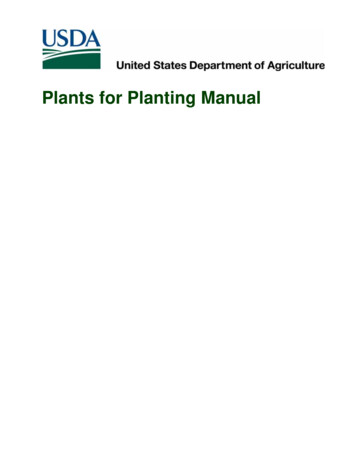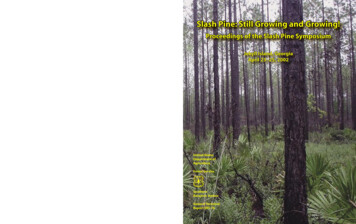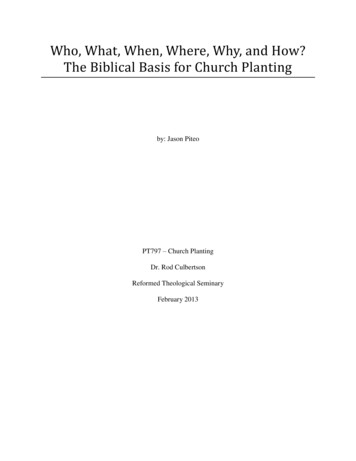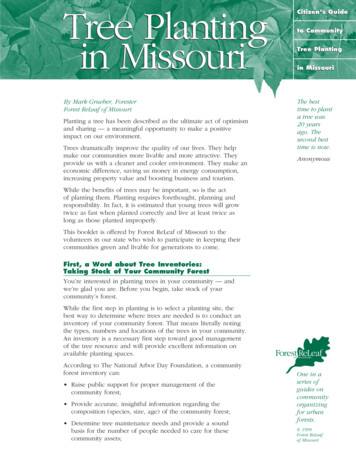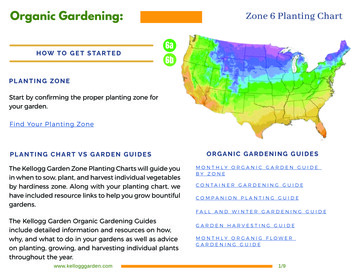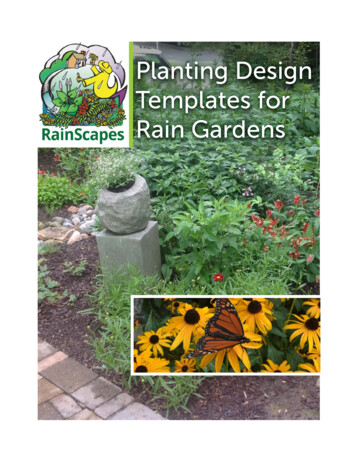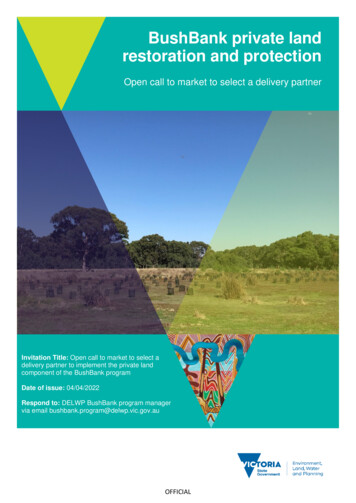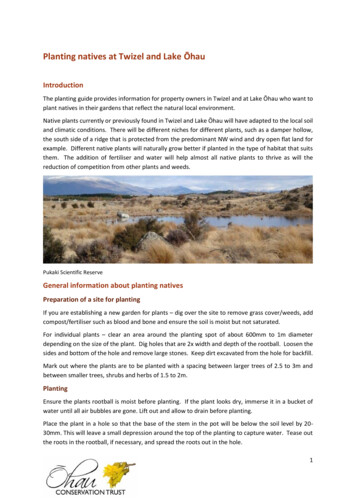
Transcription
Planting natives at Twizel and Lake ŌhauIntroductionThe planting guide provides information for property owners in Twizel and at Lake Ōhau who want toplant natives in their gardens that reflect the natural local environment.Native plants currently or previously found in Twizel and Lake Ōhau will have adapted to the local soiland climatic conditions. There will be different niches for different plants, such as a damper hollow,the south side of a ridge that is protected from the predominant NW wind and dry open flat land forexample. Different native plants will naturally grow better if planted in the type of habitat that suitsthem. The addition of fertiliser and water will help almost all native plants to thrive as will thereduction of competition from other plants and weeds.Pukaki Scientific ReserveGeneral information about planting nativesPreparation of a site for plantingIf you are establishing a new garden for plants – dig over the site to remove grass cover/weeds, addcompost/fertiliser such as blood and bone and ensure the soil is moist but not saturated.For individual plants – clear an area around the planting spot of about 600mm to 1m diameterdepending on the size of the plant. Dig holes that are 2x width and depth of the rootball. Loosen thesides and bottom of the hole and remove large stones. Keep dirt excavated from the hole for backfill.Mark out where the plants are to be planted with a spacing between larger trees of 2.5 to 3m andbetween smaller trees, shrubs and herbs of 1.5 to 2m.PlantingEnsure the plants rootball is moist before planting. If the plant looks dry, immerse it in a bucket ofwater until all air bubbles are gone. Lift out and allow to drain before planting.Place the plant in a hole so that the base of the stem in the pot will be below the soil level by 2030mm. This will leave a small depression around the top of the planting to capture water. Tease outthe roots in the rootball, if necessary, and spread the roots out in the hole.1
Place backfill in the hole, firming with fingers. Consolidate but do not compact the backfill.Blood and bone can be mixed with the backfill at the time of planting. Slow release fertiliser tabletscan also be added to the hole below the roots at planting time. Check the product’s recommendednumber of tablets based on the size of the plant.Some native plants, such as beech trees and manuka have a mutually beneficial relationship with agroup of fungi known as mycorrhizae. Seedlings of these plants purchased from a nursery will havebeen infected with the mycorrhizae during propagation.Water the plant well after planting.MulchMany native plants grow in forests or shrublands that have a deep litter mulch of decaying vegetation,leaves etc. Mulch will help protect the roots of the plants, conserve moisture and keep weeds down.Stones are an effective mulch (particularly if they are readily available on a stony site!). Stones to adepth of 100mm or so and over an area of 1m is ideal.Wet newspapers, cardboard, old wool carpet, or weed mats can also be used and covered with wetstraw, bark chips (untreated) or compost (90 to 120mm depth).Scree slope native vegetationWateringAll watering should be done thoroughly or deeply rather than often. Depending on the plant and theconditions, new plants may need deep watering 1-2 times a week for the first few weeks after plantingso they can establish well. Water in the early morning. If a good mulch has been applied at planting,the amount of watering may be less and once the plants are established may only be needed once aweek if dry hot conditions occur.After careKeeping weeds down and replenishing mulch so that a good layer of mulch remains in place will helpthe plants to grow. Fertiliser should be applied at least once a year for the first 3 years for each plant.Apply slow release fertiliser in moister late spring conditions or late summer/early autumn just beforerain is due.Wind protectionFor exposed sites, plants may need protection from the north westerly wind. This can be achieved ina variety of ways such as attaching wind cloth to the wire plant protector, erecting a wind fence arounda garden area or providing shelter through straw bales or other wind barriers. You can also plant a2
formed shelter belt of exotic trees (that are not pest trees) to create shelter for your natives. Try toinclude at least three or more different species so that if a tree gets diseased then you do not loseyour whole shelter belt. Good trees for this purpose include: leylandii, hornbeam, frost hardy gums.Rabbit browse protectionMost new plants are an attractive food source to rabbits/hares so plants will grow and establishquicker if protected from browsing. A wire mesh protector for each plant can be used or larger sitescan be protected by a perimeter rabbit proof fence. Rabbit repellent can be used but it needs to bere-applied regularly (it has not proved effective at Lake Ōhau).A wire mesh protector should be a minimum of 600mm high and of sufficient diameter to easilycontain the plant plus new growth. 900mm wide mesh allows for a 600mm height plus a flange to holddown with rocks or metal pins. Cable ties or wire can be used for tying the mesh together.Planting to reduce fire riskWith the dry environments at Twizel and Lake Ōhau, try to keep a buffer around your house free ofplants or plant less flammable species. This will help to create a defensible space around your housethat allow heat and embers to dissipate if there is a fire. You can find out more information about theflammability of native plant species in this brochure prepared by NZ Fire Service ciesbrochure.pdfBroadleaf (Griselinia littoralis) and Hebe (Veronica sp)Native plants in generalNative plants like to be planted close to each other. You will need to allow space for potential growth,but they will grow better when they can use other plants for shelter. Try mass plantings of the samespecies, these can look good and mimic what occurs naturally in the wild.Be prepared to suffer plant losses. This is normal in such a harsh environment as the Mackenzie basin.Sometimes the plant selection is wrong, the plant is not put in the right place or maybe the plant hasbeen pampered too much in the nursery beforehand!Once your native plants have matured they could potentially provide you with ‘offspring’ – youngplants – that can then be spread around your garden. Plants for free, that’s certainly a bonus!3
Grasses are very tough and can easily be divided in half or thirds before planting to get value for moneywhen you buy a plant. Make sure you soak them well first, and do not divide your plants into very tinypieces or they may die.For general planting, think about .Eco-sourced plantsSome nurseries supply native plants grown from seeds collected from plants found in the Twizel andLake Ōhau natural environments – these are called eco-sourced plants. It means the plants will besuited to local conditions and more likely to survive. By using eco-sourced native plants you will alsohelp maintain the area's unique local characteristics. Eco-sourcing will avoid the risk of plantingspecies which are not native to the local area and which could become invasive.You can collect seeds locally yourself and grow the native plants – check online for information aboutnative plant propagation including on the DOC website at ce-seeds/ You do need a permit fromDOC to collect seeds from plants growing on public conservation land.It may not be possible to find a native you want to plant that has been grown from eco-sourced seeds.Talk to the nursery about options and what plants they have available. Some nurseries may grow upsome eco-sourced plants if there is sufficient demand.What to look for when buying plantsTry to buy plants from retailers who leave their plants out in the open and not under nursery canopies.This toughens the plants up more. It is often worth checking out the bargain bin because those plantsthat have been left to dry may look terrible but they can often cope well with dry Twizel/Lake Ōhauconditions!Berries on Coprosma rugosaPlants to attract native birdsPlants with larger flowers and berries can provide a good food source to native birds such as bellbirds.Suitable plants include Kowhai, Hall’s Totara, Coprosma species, Mountain Wineberry, PorcupineShrub (also good for skinks and geckos), Weeping Mapou, flax and Broadleaf.4
Providing lizard habitatAs land becomes developed for residential use our native wildlife gets displaced. This is especially sofor skinks and geckos. An option is to create a grass and stone area that has native plants establishedsuch as Coprosma propinqua, Muehlenbeckia and Porcupine Shrub which will provide berries for food.Onduline tiles makes good shelter for lizards and will protect them from hungry predators, especiallycats.For planting at Twizel, think about Chlorinated water in TwizelThere is chlorine in the Twizel water supply. Chlorine can kill beneficial microorganisms in soil, therebyaffecting plant growth; however, most chlorinated drinking water is not concentrated enough toadversely affect plant life. If you are concerned you could collect rain water for your plants from yourhouse or shed runoff. Another alternative is to fill a large container with tap water, leave it to sit for24 hours and then it will be chlorine free.Watering your plantsThe soil in Twizel can be extremely dry, particularly if planting in autumn months. A slow phasing offwatering technique can work well. This is where you put your plant in the ground and water every dayfor the first week. Then every second day for the second week. You don’t need to water on days whereit is raining already. Gradually phase your plant out until you are watering just once a week and thenyou have ‘hardened’ it off to cope with dry spells in future. You may need to adapt your wateringprogramme by checking what the plant ‘tells’ you – you will notice if it cannot cope with less water asleaves will droop, or they may look yellow etc.Time of plantingTrees and plants grow well when planted in early autumn – March, April because they can put theirenergy into growing roots and not into growing new foliage. Plant roots need around six weeks to getestablished, so you need to try and time this before the colder temperatures arrive.Spring is another good time to plant but it is better to wait until most of the hard frosts have finished– generally October. The Twizel region especially has hard frosts as the air is often still. This meansplants do not get a lot of air movement like plantings around lake shores experience (Lake Pukaki, LakeŌhau) to keep hard frosts at bay. Cold air also sinks and Twizel township is one of the lowest areas inMackenzie Basin making it especially cold in winter. This significantly affects plant choices as they mustbe able to handle the winter temperature extremes. Plants that can cope to minus 15 degrees areideal. These same plants may succumb in a minus 22 degree frost (experienced in 2015), but they willcome away again from the roots as long as they are not shallow rooted.Improving the soilIn general the soil around Twizel area is alkaline. That is why exotic plants such as bearded irises do sowell here. The soils are also very stony and nutrient deficient so the more compost you can add whenyou dig in a plant the better. In larger lifestyle blocks you may find ‘channels’ where river water once5
flowed. These hollows become filled over time with windblown silt – this makes for much easierdigging as they are generally stone free! Take the time to study your land and see where the naturalhollows and wetter places are. This will become more obvious in late summer as certain areas dry outand other spots don’t. Those naturally damper spots will be better places to plant natives such asMountain Flax that really don’t like drying out.Shingle mulch for native plantsSuitable Native Species for TwizelAll the plants listed below are found naturally in the Mackenzie Basin. This list is a guide only, you willneed to research plant sizes and site preferences to suit your garden requirements.Key: FR fire resistant, Birds attracting birds, ST shade tolerantTreesMountain beechFuscospora cliffortioidesMountain ribbonwoodHoheria lyalliFRHall’s totaraPodocarpus laetusBirdsShrubs – up to 5m tallMountain wineberryAristotelia fruticosaBirdsBrachyglottis cassinioidesCoral broomCarmichaelia crassicaulisGood plant for the dryDwarf broomCarmichaelia nanaGood plant for the dryDesert broomCarmichaelia petrieiGood plant for the dryCoprosma intertextaBirdsCoprosma propinquaBirdsCoprosma rugosaBirds, FR, Tough coprosmaMingimingi6
MatagouriDiscaria toumatouPorcupine shrubMelicytus alpinusVery slow growingWeeping matipoMyrsine divaricataBirdsOlearia bullataBirdsOlearia nummulariifoliaBirdsOlearia odorataBirdsOlearia virgataBirdsMountain flaxPhormium cookianumBirds, Don’t let dry out untilmatureSnow totaraPodocarpus nivalisBirds, Don’t let dry outHebeVeronica cupressoidesEasy to growScented tree daisyTe Manahuna/Twizel Department of Conservation native gardenSmall shrubs/plants – up to 1 m tallAlpine fernBlechnum penna-marinaCopes with dry sitesBrachyglottis haastiiDislikes exposed sitesDwarf broomCarmichaelia vexillataCommon mountain daisyCelmisia gracilentaRock fernCheilanthes humilisCoprosma cheesmaniiBirdsCoprosma ciliataBirdsDwarf mingimingiLeucopogon fraseriCreeping pohuehueMuehlenbeckia axillarisCottonwoodOzothamnus leptophyllusEasy to growPellaea calidirupium7
Native daphnesPimeleatraversiiprostrata,Veronicas (aka Hebes)Veronica buchananiiPimeleaVeronica lycopodioidesVeronica salicifoliaFR, BirdsVeronica subalpinaVeronica treadwelliiEasy to grow but don’t let dryoutClimbersWire vineMuehlenbeckia complexaNew Zealand jasmineParsonsia capsularisTussocks, grasses, herbs and small plantsGolden speargrassAciphylla aureaDon’t overwaterAciphylla subflabellataDon’t overwaterSlim snow tussockChionochloa macraDon’t let dry outNarrow-leaved snow tussockChionochloa rigidaDon’t let dry outBlue fescueFestuca matthewsiiEasy to growHard tussockFestuca novae-zelandiaeEasy to growScree poaPoa buchananiiSilver tussockPoa citaEasy to growBlue tussockPoa colensoiEasy to growRytidosperma pumilumTiny plants**BidibidAcaena fissistipulaGlaucus bidibidAceana caesiiglaucaAnisotome aromaticaBrachyglottis bellidioidesCallitriche petriei subsp petrieiCarex breviculmisChaerophyllumcolensoi8colensoivar.
Colobanthus acicularisColobanthus strictusTussock bindweedConvolvulus verecundusEpilobium angustumDwarf bedstrawGalium perpusillumGrass lilyHerpolirion novae-zelandiaeKelleria lyalliiLeptinella pectinataDry stony groundSouth Island EdelweissLeucogenes grandicepsGrows in rocky outcropsMountain lobeliaLobelia linnaeoides (creeping herb)Muehlenbeckia ephedroidesPhyllachne colensoiScree buttercupRanunculus crithmifoliusGrassland buttercupsRanunculus gracilipes, RanunculusmultiscapusUtricularia dichotomaMountain violetViola cunninghamii**Some of the less common plants listed may be purchased from specialised plant nurseries, orthrough Alpine Plant Societies Showdays.Ahuriri tops – perfect natural landscapingMat/cushion plantsdwarf BroomCarmichaelia nanaCoprosma atropurpureaKelleria dieffenbachiiPratiaLobelia angulata9
Pentachondra pumilaCommon mat daisyRaoulia australisFan-leaved mat daisyRaoulia monroiCeladon mat daisyRaoulia parkiiTurf mat daisyRaoulia subsericeaScleranthus uniflorusDo not overwaterCarex coriaceaWill grow in well-drained soilWetland plantsCutty grassCarex buchananiiCarex gaudichaudianaMaori sedgeCarex maoricaPureiCarex sectaWill grow in well drained soilGlossostigma elatinoidesManiototo button daisyLeptinella maniototoLimosella lineataPotamogeton cheesemaniiLake Tekapo township native plantings10Grows in ponds
For planting at Lake Ōhau, think about Timing of plantingBest in the autumn months of April to May because they can put their energy into growing roots andnot into growing new foliage. Possible to plant in late winter and early spring (August to September)but intensive watering may be required to keep the plants alive over the following dry summer.Improving the soilThere are generally stony and clay soils around the Village (with patches of better soil) that will benefitfrom the addition of compost, blood and bone or other well-rotted organic material before planting.Fertilisers can also be added such as slow release fertiliser tablets.Dry environment planting at Lake ŌhauSuitable Native Species for Lake ŌhauAll the plants listed below are found naturally around the western side of Lake Ōhau. This list is aguide only, you will need to research plant sizes and site preferences to suit your garden requirements.Key: FR fire resistant, Birds attracting birds, ST shade tolerantTreesMountain and Black BeechFuscospora cliffortioidesFuscospora solandriBroadleafGriselinia littoralisFR, ST, plant in a sheltered spotMountain RibbonwoodHoheria lyalliiFR, deciduousCelery PinePhyllocladus alpinusKohuhuPittosporum tenuifoliumMay suffer in extreme cold (15oc)Hall’s TotaraPodocarpus laetusBirdsFierce LancewoodPseudopanax feroxFRSouth Island KowhaiSophoravariety)microphyllaand(Ōhau Birds11
Shrubs – up to 5m tallMountain WineberryAristotelia fruticosaBirdsBrachyglottis cassinioidesNative BroomCarmichaelia petrieiGood plant for the dryCoprosma speciesCoprosma intertextaBirdsMingimingiCoprosma propinquaBirds, STCoprosma rugosaFR, Birds, STCoprosma dumosaBirdsKorokioCorokia cotoneasterBirdsMatagouriDiscaria toumatouInakaDracophyllum longifoliumCan be tricky to growTurpentine BushDracophyllum uniflorumCan be tricky to growBush snowberryGaultheria antipodaGaultheria crassaSnowberryGaultheria depressa var novaezelandiaeManukaLeptospermum scopariumPorcupine ShrubMelicytus alpinusVery slow growingWeeping MapouMyrsine divaricataBirds, STMountain akeakeOlearia avicenniifoliaBirdsBush DaisyOlearia bullataBirdsShrub DaisyOlearia nummulariifoliaBirdsScented tree daisyOlearia odorataBirdsMountain flaxPhormium cookianumDon’t let dry out until mature,BirdsFlaxPhormium tenaxPittosporum (pit pat)Pittosporum patulumHard to source plantsSnow TotaraPodocarpus nivalisDon’t let dry outHebeVeronica cupressoidesEasy to grow12
Small shrubs up to 1mBrachyglottis haastiiDwarf mingimingiLeucopogon fraseriCreeping pohuehueMuehlenbeckia axillarisCottonwoodOzothamnus leptophyllusNative DaphnePrimelea traversiiVeronica (aka Hebe) speciesVeronica pauciramosaKoromikoVeronica salicifoliaDislikes exposed sitesEasy to growFR, BirdsVeronica subalpinaMingimingi (Coprosma propinqua) and hebe (Veronica sp) at Lake ŌhauClimbersWire vineMuehlenbeckia complexaParsonia heterophyllaBush lawyer/tataramoaRubus schmidelioiodesTussocks, grasses, ferns, herbs and small plantsGlaucus bidibidAceana caesiiglaucaGolden SpaniardAciphylla aureaBlue wheatgrassAnthosachne solandriButterfly fernAsplenium flabellifoliumToetoeAustroderia richardiiAlpine fernBlechnum penna-marinaSedgeCarex virgataMountain daisyCelmisia spectabilisLarge snow tussockChionochloa flavescensNarrow-leavedtussocksnow Chionochloa rigidaDon’t overwaterDon’t let dry out13
Red tussockChionochloa rubraFescue/Hard tussockFestuca novae-zelandiaePennywortHydrocotyle novae-zeelandiae var.montanaRed woodrushLuzula rufaSilver tussockPoa citaEasy to growBlue tussockPoa colensoiEasy to growPrickly shield fernPolysticum vestitumBrackenPteridium esculentumCommon mat daisyRaoulia australisMountain heathAcrothamnus colensoiTussock and toetoe border at Lake Ōhau14Easy to growMat plant
Other suitable native plantsThese plants are not found naturally in the wild but should grow well in gardens here.Key: FR fire resistant, Birds attracting birds, ST shade tolerantTrees and shrubs over 1mOlearia lineataBirdsAkiraho, golden akeakeOlearia paniculataBirdsRibbonwoodPlagianthus regiusBirdsShrubs/grasses under 1mHells BellsAnaphaloides belliodoidesGossamer grassAnamanthele lessonianaEasy to grow and copes withdryChatham Island astelia or Astelia chathamica cv Silver STkakaha, Moriori flaxSpearSedgeCarex comansSand coprosmaCoprosma acerosaBirdsCoprosma brunneaBirdsBlueberryDianella nigraCopes with dry and STBanks Peninsula FescueFestuca actaeNew Zealand irisLibertia ixioidesShrubby tororaraMuehlenbeckia astoniiOlearia fragrantissimaMarlborough rock daisyScabweed,daisyscabweedCopes with dry, BirdsPachystegia insignismat Raoulia hookeriiArmstrongs Whipcord HebeVeronica armstrongiiVeronicas (aka Hebes)Veronica decumbensEasy to grow and handles dryVeronica pimeleoidesVeronica pinguifoliaVeronica topiaria15
Note: This document provides a guide to planting natives but it is not definitive and there are othernative plant species that are found in the Mackenzie Basin that you can grow in your garden. A goodresource to identify native plants is at NZ Flora - http://www.nzflora.info/index.htmlThis planting guide has been prepared by The Ōhau Conservation Trust. The Trust wishes to thank thestaff of the Department of Conservation Te Manahuna/Twizel Office for their contributions ofenthusiasm for the project and knowledge and expertise about native plants.Guide updated 25 July 2021.To find out more about the Ōhau Conservation Trust visit www.ohauconservationtrust.nz16
Talk to the nursery about options and what plants they have available. Some nurseries may grow up some eco-sourced plants if there is sufficient demand. What to look for when buying plants Try to buy plants from retailers who leave their plants out in the open and not under nursery canopies. This toughens the plants up more.
